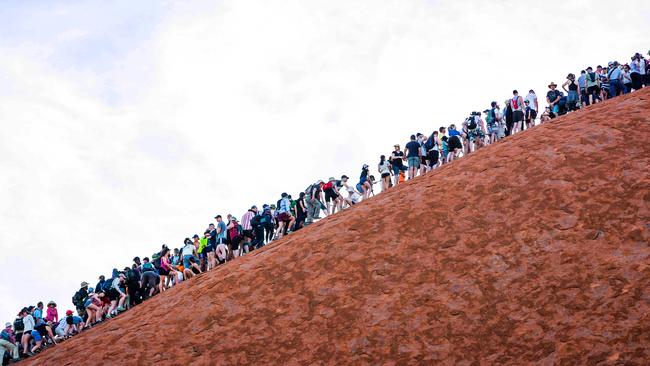
So there has been a nationwide rush to do just that. This last-minute dash to the top of the rock has seen thousands of Australians travel vast distances to converge in overflowing carparks and line up to scale what will soon become the forbidden summit.
Pictures this week looked like a scene out of that Hollywood epic in which Charlton Heston led the children of Israel out of Egypt by parting the waters of the Red Sea.
If you believe that piece of ancient mythology, why would you have any trouble accepting the spirits of Uluru? I am ecumenical in my disbelief. All religions are occult and at the heart of all religious observances, weird rituals, preposterous beliefs, taboos and injunctions, is a formidable rock face, monolithic as Uluru in its denial of rational argument. (Don’t write in, I won’t read it.)
For years, the official Uluru-Kata Tjuta website put it perhaps too simply: “We ask visitors not to climb Uluru because of its spiritual significance as the traditional route of the ancestral Mala men on their arrival at Uluru.”
The site quotes an unnamed traditional owner, who says: “That (Uluru) is a really important thing that you’re climbing. You shouldn’t climb. It’s not the real thing about this place. The real thing is listening to everything.”
I quite like that last line but it doesn’t explain much, especially for Bert and Beryl from Burnie. “We’ve come a long way and I’m not going to leave without climbing Ayers Rock,” Bert (betraying his age) declared this week.
Meanwhile, Beryl spoke for a lot of the folk queuing up to climb the 348m in the cool of the early morning: “Why shouldn’t we climb our rock? It means so much to all Australians. It’s a national disgrace. It belongs to everybody.”
The decision to ban Bert and Beryl from next week is hardly democratic. The Uluru-Kata Tjuta board comprising 12 people who voted unanimously to shut down climbing on the 34th anniversary of Uluru land title being handed back to the Anangu people.
“It is an extremely important place, not a playground or a theme park like Disneyland,” board chairman Sammy Wilson told The Australian. “If I travel to another country and there is a sacred site, an area of restricted access, I don’t enter or climb it, I respect it. “It is the same here for the Anangu people. We … are not stopping tourism, just this activity.”
I had the chance to climb Uluru when I was last filming there, but the local custodians had asked us to film only near the base and we respected their wishes.
This nation has taken so much from our original people, to indulge what might be considered a romantic superstition seemed the least we could do.
I don’t believe in virgin birth, transubstantiation, resurrection, angels or life after death, but I would never deliberately profane a site sacred to those who do. And there is always a chance that I am wrong about religion. When I die, how confounding it might be to meet the Rainbow Serpent.
Uluru is often called “the navel of Australia”. Which might make the great lump of rock overshadowing my home town of Hobart, to the very far south, “the bunion of Australia”. In these days of political correctness, we call it Kunanyi/Mount Wellington.
There are plans for a $54m cable car to run up the bunion and across the dramatic fluted rock face known as the Organ Pipes. Debate over it never goes away.
Kunanyi is sacred to some of the white tribes of Hobart, among them the Japara people, the Kathmandu tribe, and a more widespread group helpfully identified by Tasmania’s leading political anthropologist, senator Jonathon Duniam, as “the Anti-Everything Brigade”. That is perhaps our most powerful tribe. Depending what is threatening our own backyard at the time, most of us in Tasmania are at least transient members.
Good luck keeping your seat at the next election, senator, but thanks for giving us the name.
Telling a developer with the smell of money in his nostrils to leave the sacred mountain alone will not stop him. Standing in its alpine groves, hearing the bird song and soaking up the peace, will never be enough.
The whirring of an overhead mechanical contrivance “enhancing the tourist experience” will not be silenced by quoting the Uluru man’s wisdom: “The real thing is listening to everything.”
For developers any mechanical noise in a “sacred site” most probably sounds like the clatter of coin.
Years ago, I covered an environmental battle in the Northern Territory at a place called Coronation Hill, where the local tribal elders had held up what promised to be a billion-dollar mining development. I sat on the ground with the Jawoyn leaders and learned that although their people needed the money, they couldn’t let the development go ahead because the proposed mine was the resting place of the creator being, Bula.
The elders told me: “We think this place is sacred but the miners don’t understand what that means.” In the end, Bula won with a little help from Bob Hawke.
These matters are never easy and no longer does Australia possess a great negotiator like Hawke. Without skilful diplomacy, the task of negotiating tourism atop Uluru or stopping a cable car on Kunanyi will be always be bitter, fraught and unfinished business.
Preservation versus profit is the irreconcilable argument of our times. Uluru and Kunanyi symbolise an important question: where is the middle ground between those people for whom everything is sacred, and those for whom nothing is?
Charles Wooley is a reporter for the Nine Network’s 60 Minutes.




I’ve never climbed Uluru and now I doubt I ever will. Not because of gathering infirmities but because it will no longer be allowed. Last year, the rock’s management authority, the Uluru-Kata Tjuta National Park board, announced that from October 26 visitors would be banned from climbing.